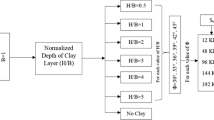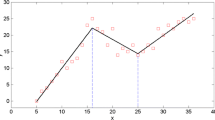Abstract
In geotechnical planning methods, the undrained shear strength of clayey soil is very important as one of the engineering features. Over the past years, several theoretical and empirical methods have been developed to estimate the undrained shear strength based on soil properties using in-situ tests such as cone and piezocone penetration tests. However, most of these methods involve correlation assumptions that can result in inconsistent accuracy. In this study, multivariate adaptive regression splines (MARS) model with different degrees of interactions was developed for predicting the undrained shear strength of soil from cone penetration test data. To this aim, the model had five variables named cone tip resistance, sleeve friction, liquid limit, plastic limit, and overburden weight as inputs and undrained shear strength of soil as output. In all proposed models, the estimated USS values demonstrate acceptable agreement with experimental records, representing the workability of proposed equations for predicting the USS values with high accuracy. Comparison of three developed equations supplied that MARS-O4 has a better result than MARS-O3, followed by MARS-O2. Furthermore, by apprising the PI and OBJ indexes, the MARS-O4 model outperforms the other two models, with lower PI and OBJ values equal to 0.1464 and 169.14. Therefore, the 4th interaction equation of MARS for predicting the undrained shear strength of soil can be recognized as the proposed regression model.





Similar content being viewed by others
References
Abu-Farsakh MY, Mojumder MAH (2020) Exploring artificial neural network to evaluate the undrained shear strength of soil from cone penetration test data. Transp Res Rec 2674(4):11–22
Abu-Farsakh M, Tumay M, Voyiadjis G (2003) Numerical parametric study of piezocone penetration test in clays. Int J Geomech 3(2):170–181
Benemaran RS, Esmaeili-Falak M (2020) Optimization of cost and mechanical properties of concrete with admixtures using MARS and PSO. Comput Concr 26(4):309–316. https://doi.org/10.12989/cac.2020.26.4.309
Cheng M-Y, Cao M-T (2014) Accurately predicting building energy performance using evolutionary multivariate adaptive regression splines. Appl Soft Comput 22:178–188
Das SK, Basudhar PK (2006) Undrained lateral load capacity of piles in clay using artificial neural network. Comput Geotech 33(8):454–459
Esmaeili Falak M, Sarkhani Benemaran R, Seifi R (2020) Improvement of the mechanical and durability parameters of construction concrete of the qotursuyi spa. Concr Res 13(2):119–134. https://doi.org/10.22124/JCR.2020.14518.1395
Esmaeili-Falak M, Katebi H, Javadi A, Rahimi S (2017) Experimental investigation of stress and strain characteristics of frozen sandy soils—A case study of Tabriz subway. Modares Civ Eng J 17(5):13–23
Esmaeili-Falak M, Katebi H, Javadi A (2018) Experimental study of the mechanical behavior of frozen soils—A case study of tabriz subway. Period Polytech Civ Eng 62(1):117–125
Esmaeili-Falak M, Katebi H, Vadiati M, Adamowski J (2019) Predicting triaxial compressive strength and Young’s modulus of frozen sand using artificial intelligence methods. J Cold Regions Eng 33(3):4019007. https://doi.org/10.1061/(ASCE)CR.1943-5495.0000188
Esmaeili-Falak M, Katebi H, Javadi AA (2020) Effect of freezing on stress-strain characteristics of granular and cohesive soils. J Cold Regions Eng 34(2):05020001. https://doi.org/10.1061/(ASCE)CR.1943-5495.0000205
Esmaeili-Falak M (2017) Effect of system’s geometry on the stability of frozen wall in excavation of saturated granular soils. Doctoral dissertation, University of Tabriz
Friedman JH (1991) Multivariate adaptive regression splines. Ann Stat 2:1–67
Friedman JH, Roosen CB (1995) An introduction to multivariate adaptive regression splines. Sage Publications Sage CA, Thousand Oaks
Hastie T, Tibshirani R, Friedman JH (2003) The elements of statistical learning, corrected. In: Haxby JV, Gobbini MI, Furey ML, Ishai A, Schouten JL, Pietrini P (eds) Distributed and overlap** representations of faces and objects in ventral temporal cortex, vol 293. Springer, Berlin, p 24252430
Huang W, Sheng D, Sloan SW, Yu HS (2004) Finite element analysis of cone penetration in cohesionless soil. Comput Geotech 31(7):517–528
Ikizler SB, Aytekin M, Vekli M, Kocabaş F (2010) Prediction of swelling pressures of expansive soils using artificial neural networks. Adv Eng Softw 41(4):647–655
Jekabsons G (2016) ARESLab: adaptive regression splines toolbox for Matlab/Octave, 2011. http://www.cs.rtu.lv/jekabsons
Lunne T (1982) Role of CPT in North Sea foundation engineering
Masoumi F, Najjar-Ghabel S, Safarzadeh A, Sadaghat B (2020) Automatic calibration of the groundwater simulation model with high parameter dimensionality using sequential uncertainty fitting approach. Water Supply 20(8):3487–3501
Mojumder MAH (2020) Evaluation of undrained shear strength of soil, ultimate pile capacity and pile set-up parameter from cone penetration test (CPT) using artificial neural network (ANN)
Nassr A, Esmaeili-Falak M, Katebi H, Javadi A (2018) A new approach to modeling the behavior of frozen soils. Eng Geol 246:82–90. https://doi.org/10.1016/j.enggeo.2018.09.018
Neaupane KM, Achet SH (2004) Use of backpropagation neural network for landslide monitoring: a case study in the higher Himalaya. Eng Geol 74(3–4):213–226
Nejad FP, Jaksa MB (2017) Load-settlement behavior modeling of single piles using artificial neural networks and CPT data. Comput Geotech 89:9–21
Poorjafar A, Esmaeili-Falak M, Katebi H (2021) Pile-soil interaction determined by laterally loaded fixed head pile group. Geomech Eng 26(1):13–25. https://doi.org/10.12989/gae.2021.26.1.013
Raja MNA, Shukla SK (2021) Multivariate adaptive regression splines model for reinforced soil foundations. Geosynth Int 21:1–23
Sahraei MA, Duman H, Çodur MY, Eyduran E (2021) Prediction of transportation energy demand: multivariate adaptive regression splines. Energy 224:120090
Salgado R, Boulanger RW, Mitchell JK (1997) Lateral stress effects on CPT liquefaction resistance correlations. J Geotech Geoenviron Eng 123(8):726–735
Samui P, Kurup P (2012) Multivariate adaptive regression spline and least square support vector machine for prediction of undrained shear strength of clay. Int J Appl Metaheuristic Comput (IJAMC) 3(2):33–42
Sarkhani Benemaran R (2017) Experimental and analytical study of pile-stabilized layered slopes. Tabriz University, Tabriz
Sarkhani Benemaran R, Esmaeili-Falak M, Katebi H (2020) Physical and numerical modelling of pile-stabilized saturated layered slopes. Proc Inst Civ Eng Geotech Eng. https://doi.org/10.1680/jgeen.20.00152
Sekulic S, Kowalski BR (1992) MARS: a tutorial. J Chemom 6(4):199–216
Senneset K (1982) Strength and deformation parameters from cone penetration tests
Shahin MA, Maier HR, Jaksa MB (2002) Predicting settlement of shallow foundations using neural networks. J Geotech Geoenviron Eng 128(9):785–793
Shahin MA, Jaksa MB, Maier HR (2009) Recent advances and future challenges for artificial neural systems in geotechnical engineering applications. Adv Artif Neural Syst 2009:2
Teh CI, Houlsby GT (1991) An analytical study of the cone penetration test in clay. Geotechnique 41(1):17–34
Xu Q-S et al (2004) Multivariate adaptive regression splines—Studies of HIV reverse transcriptase inhibitors. Chemom Intell Lab Syst 72(1):27–34
Yu HS, Whittle AJ (1999) Combining strain path analysis and cavity expansion theory to estimate cone resistance in clay. Unpublished notes
Zhang W, Wu C, Li Y, Wang L, Samui P (2021) Assessment of pile drivability using random forest regression and multivariate adaptive regression splines. Georisk Assess Manag Risk Eng Syst Geohazards 15(1):27–40
Zhang W, Wu C, Zhong H, Li Y, Wang L (2021) Prediction of undrained shear strength using extreme gradient boosting and random forest based on Bayesian optimization. Geosci Front 12(1):469–477. https://doi.org/10.1016/j.gsf.2020.03.007
Acknowldgements
Science and Technology Planning Project of Nantong City, JiangSu Province (MS22020021), College Students Innovation and Entrepreneurship Training Program of JiangSu Province (202012703018Y), Scientific Research Project of JiangSu Ship** College (HYKY/2020B01).
Author information
Authors and Affiliations
Corresponding author
Additional information
Publisher's Note
Springer Nature remains neutral with regard to jurisdictional claims in published maps and institutional affiliations.
Rights and permissions
About this article
Cite this article
Yu, D. Develo** multivariate adaptive regression splines model for predicting the undrained shear strength of clayey soil from cone penetration test data. Multiscale and Multidiscip. Model. Exp. and Des. 5, 215–224 (2022). https://doi.org/10.1007/s41939-021-00113-6
Received:
Accepted:
Published:
Issue Date:
DOI: https://doi.org/10.1007/s41939-021-00113-6




